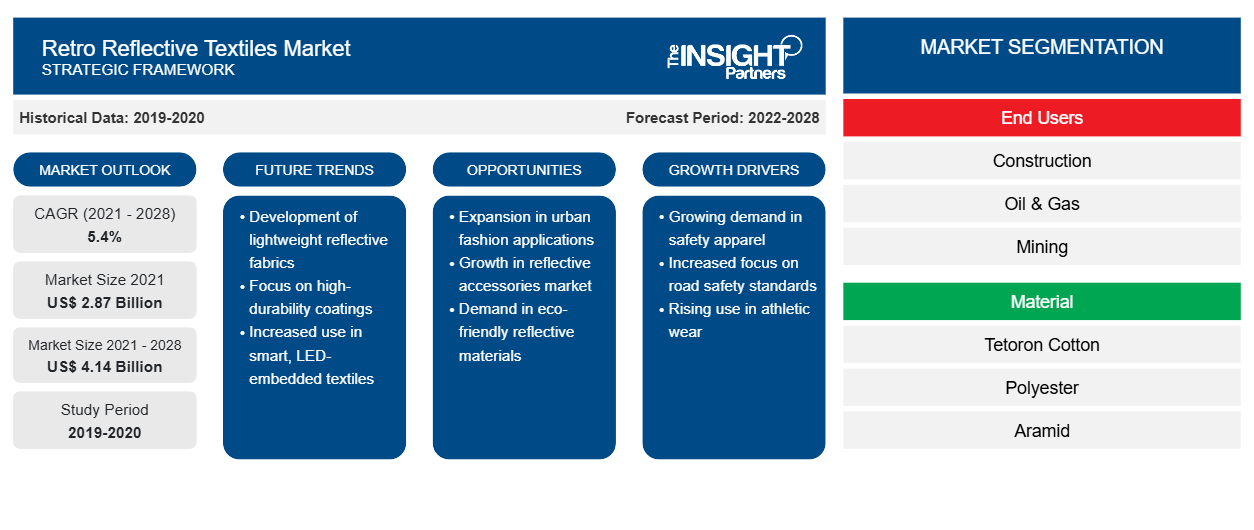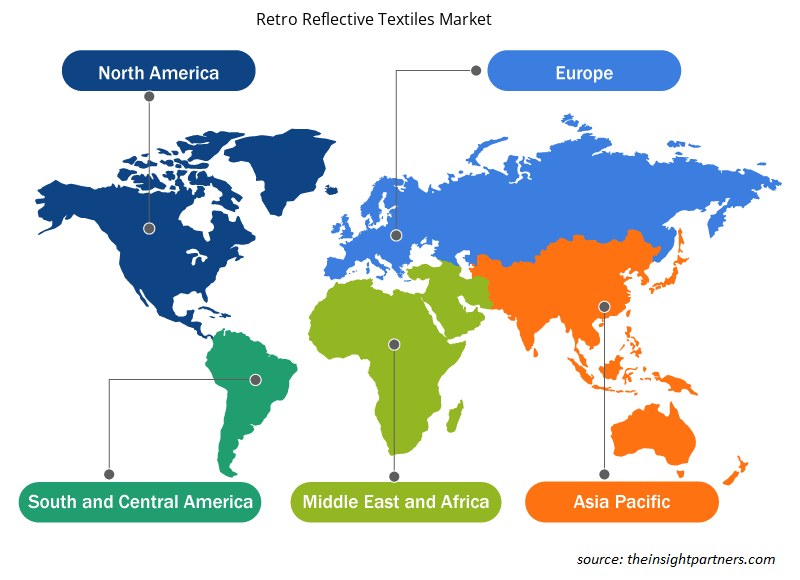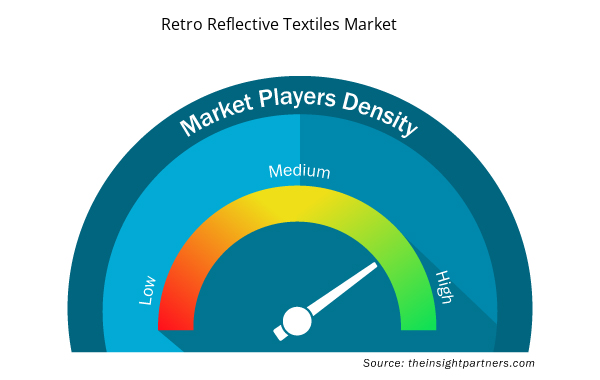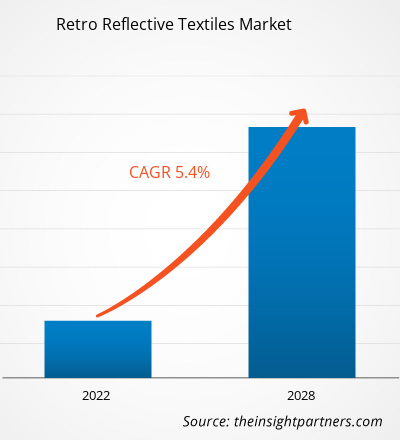[Research Report] The retro reflective textiles market is expected to grow from US$ 2,872.8 million in 2021 to US$ 4,139.8 million by 2028; it is estimated to grow at a CAGR of 5.4% from 2021 to 2028.
Retro reflective fabric is made using small glass beads which reflect light back to the source. It is highly used in protective wear in industries, such as the construction & transportation industry. The demand for retro reflective textile has increased due to the safety regulations placed by various governments. Moreover, the growing number of accidents in the end user industries, such as the mining industry, has propelled the demand for retro reflective textiles.
In 2020, Asia Pacific held the largest share of the global market; it is estimated to register the highest CAGR during the forecast period. India, China, and Japan are among the major market shareholders. The high growth of industries, such as automotive, transportation, construction, and infrastructure, significantly impacted the APAC retro reflective textiles market. The construction & infrastructure industry is growing in Asia Pacific.
Customize This Report To Suit Your Requirement
You will get customization on any report - free of charge - including parts of this report, or country-level analysis, Excel Data pack, as well as avail great offers and discounts for start-ups & universities
Retro Reflective Textiles Market: Strategic Insights

- Get Top Key Market Trends of this report.This FREE sample will include data analysis, ranging from market trends to estimates and forecasts.
You will get customization on any report - free of charge - including parts of this report, or country-level analysis, Excel Data pack, as well as avail great offers and discounts for start-ups & universities
Retro Reflective Textiles Market: Strategic Insights

- Get Top Key Market Trends of this report.This FREE sample will include data analysis, ranging from market trends to estimates and forecasts.
Impact of COVID-19 Pandemic on Retro Reflective Textiles Market
In 2021, the economies started reviving their operations, positively impacting the global marketplace. The demand for retro reflective textiles is also projected to increase significantly for different applications, such as manufacturing safety apparel. Moreover, the manufacturers can operate at full capacity to overcome the demand and supply gap. Additionally, many citizens of various nations are fully vaccinated, and governments of different countries are making investments in construction, infrastructure, and manufacturing sectors. The growth of various end use industries is expected to result in high demand for retro reflective textiles over forecast period.
Market Insights
Growing Importance of Workforce Safety Measures and High Visibility Safety Apparel (HVSA)
Accidents and fatalities are becoming more common in workplaces, such as roadways at construction sites, oil & gas industries, chemical industries, and mining sites, where low visibility is an issue. Heavy machinery, including cranes, is frequently used in industrial areas. Workers with a lack of protective equipment are more likely to have accidents, injuries, and fatalities as they cannot be spotted easily by the operators of such heavy machinery. Moreover, millions of workers are prone to struck by, run over, and backover incidents while working near traffic and construction equipment. The increasing importance of workplace safety is expected to drive the growth of the retro reflective textiles market over the forecast period.
End User Insights
Based on end user, the global market is segmented into construction, oil & gas, mining, transportation, firefighters, law enforcement agencies, and others. In 2020, the construction segment accounted for the largest revenue share; it is expected to grow at the highest CAGR over the forecast period. The construction site is growing with rapid urbanization, which leads to many thermal-based environment problems represented by the urban heat island. These reflectors are used in signboards, personnel apparel, and vehicles at construction sites. Retro reflective textiles have been suggested as an innovative solution to reduce the energy required for cooling and improve urban microclimates. Retro reflective textiles materials enhance visibility and are essential accessory materials. Moreover, a rapid increase in construction & infrastructure activities led to a rise in the use of signboards and road color marking, which propels the growth of the market. The primary driver of the retro reflective textiles market is the large-scale investment in the construction & infrastructure sector.
3M; Daoming Optics & Chemical Co., Ltd; Hangzhou Chinastars Reflective Material Co.,Ltd; Huangshan Xingwei Reflectorized Material Co., Ltd.; P S ENTERPRISES; Swicofil AG; Unitika Sparklite Ltd.; YGM Reflective; HJ Corp; and HIGHVIZ are among the players operating in the retro reflective textiles market. These companies provide a wide range of product portfolios for the market. The presence of these companies in the developing regions offers lucrative opportunities for the retro reflective textiles market. The market players are developing high-quality and innovative products to meet customer’s requirements.
Retro Reflective Textiles Market Regional Insights
The regional trends and factors influencing the Retro Reflective Textiles Market throughout the forecast period have been thoroughly explained by the analysts at Insight Partners. This section also discusses Retro Reflective Textiles Market segments and geography across North America, Europe, Asia Pacific, Middle East and Africa, and South and Central America.

- Get the Regional Specific Data for Retro Reflective Textiles Market
Retro Reflective Textiles Market Report Scope
| Report Attribute | Details |
|---|---|
| Market size in 2021 | US$ 2.87 Billion |
| Market Size by 2028 | US$ 4.14 Billion |
| Global CAGR (2021 - 2028) | 5.4% |
| Historical Data | 2019-2020 |
| Forecast period | 2022-2028 |
| Segments Covered |
By End Users
|
| Regions and Countries Covered | North America
|
| Market leaders and key company profiles |
Retro Reflective Textiles Market Players Density: Understanding Its Impact on Business Dynamics
The Retro Reflective Textiles Market is growing rapidly, driven by increasing end-user demand due to factors such as evolving consumer preferences, technological advancements, and greater awareness of the product's benefits. As demand rises, businesses are expanding their offerings, innovating to meet consumer needs, and capitalizing on emerging trends, which further fuels market growth.
Market players density refers to the distribution of firms or companies operating within a particular market or industry. It indicates how many competitors (market players) are present in a given market space relative to its size or total market value.
Major Companies operating in the Retro Reflective Textiles Market are:
- 3M
- Daoming Optics and Chemical Co., Ltd
- HANGZHOU CHINASTARS REFLECTIVE MATERIAL CO.,LTD
- Huangshan Xingwei Reflectorized Material Co., Ltd
- PROMOSTY
Disclaimer: The companies listed above are not ranked in any particular order.

- Get the Retro Reflective Textiles Market top key players overview
Report Spotlights
- Progressive industry trends in the market to help players develop effective long-term strategies
- Business growth strategies adopted by developed and developing markets
- Quantitative analysis of the retro reflective textiles market from 2019 to 2028
- Estimation of global demand for retro reflective textiles
- Porter’s five forces analysis illustrates the efficacy of buyers and suppliers operating in the industry
- Recent developments to understand the competitive market scenario
- Market trends and outlook as well as factors driving and restraining the growth of the retro reflective textiles market
- Assistance in decision-making process by highlighting market strategies that underpin commercial interest, leading to the market growth
- The size of the market at various nodes
- Detailed overview and segmentation of the market, as well as the retro reflective textiles industry dynamics
- Size of the retro reflective textiles market in various regions with promising growth opportunities
The "Global Retro Reflective Textiles Market Analysis to 2028" is a specialized and in-depth study of the chemicals and materials industry with a special focus on the global retro reflective textiles market. The report aims to provide an overview of the market with detailed market segmentation. The retro reflective textiles market is segmented on the basis of end users, material, and geography. Based on end users, the retro reflective textiles market is segmented into construction, oil and gas, mining, transportation, firefighters, law enforcement agencies, and others. Based on material, the market is segmented into tetoron cotton, polyester, aramid, and others. By geography, the retro reflective textiles market is broadly segmented into North America, Europe, Asia Pacific (APAC), the Middle East & Africa (MEA), and South & Central America.
Company Profiles
- 3M
- Daoming Optics & Chemical Co., Ltd
- Hangzhou Chinastars Reflective Material Co.,Ltd
- Huangshan Xingwei Reflectorized Material Co., Ltd.
- P S ENTERPRISES
- Swicofil AG
- Unitika Sparklite Ltd.
- YGM Reflective
- HJ Corp
- HIGHVIZ
- Historical Analysis (2 Years), Base Year, Forecast (7 Years) with CAGR
- PEST and SWOT Analysis
- Market Size Value / Volume - Global, Regional, Country
- Industry and Competitive Landscape
- Excel Dataset



Report Coverage
Revenue forecast, Company Analysis, Industry landscape, Growth factors, and Trends

Segment Covered
End Users and Material

Regional Scope
North America, Europe, Asia Pacific, Middle East & Africa, South & Central America

Country Scope
Argentina, Australia, Brazil, Canada, China, France, Germany, India, Italy, Japan, Mexico, Russian Federation, Saudi Arabia, South Africa, South Korea, United Arab Emirates, United Kingdom, United States
Frequently Asked Questions
What are the trends for the global retro reflective textiles market?
Development of fashion clothing with retro reflective fabric is the key trend for the global retro reflective textiles market. The retro reflective materials are gaining massive traction in the fashion industry. The reflective fabric has become a new fashion trend in recent years, with it being extensively utilized in casual clothing, fashion wear, backpacks, pet jackets, and much more.
Based on end-user, which segment led the global retro reflective textiles market in 2020?
Based on end-user, the construction segment led the global retro reflective textiles market in 2020. At construction sites, the worker are required to wear high visibility safety apparel to avoid accidents and help the oncoming traffic to spot them.
Which material segment is the fastest growing in the retro reflective textiles globally?
Based on the material segment, tetoron cotton is expected to be the fastest-growing segment. The material segment includes tetoron cotton, polyester, aramid and others.
What are the drivers for the growth of the global retro reflective textiles market?
Growing importance of workforce safety measures and high visibility safety apparel (HVSA) along with rising demand from various end-use industries drives the retro reflective textile industry. The primary growth driver identified in the retro reflective textiles market is the large-scale investment in the construction and infrastructure sector. It is anticipated that infrastructural connectivity projects such as the expansion of road and railway networks would generate extensive demand for safety materials used in these projects. The retro reflective textiles market is expected to witness a significant boost in the coming years.
In 2020, which region held the largest share of the global retro reflective textiles market?
In 2020, Asia Pacific accounted for the largest share of the global retro reflective textiles market. The retro reflective textile industry is anticipated to expand faster due to increasing awareness of work safety clothes and high visibility safety apparel.
Can you list some major players operating in the global retro reflective textiles market?
The major players operating in the global retro reflective textiles market are 3M; Daoming Optics and Chemical Co., Ltd; HANGZHOU CHINASTARS REFLECTIVE MATERIAL CO., LTD; Huangshan Xingwei Reflectorized Material Co., Ltd; PROMOSTY; PS Enterprises; Shelby Ltd; Swicofil AG; UNITIKA SPARKLITE LTD.; V-Reflex Reflective Material Co., Ltd.
Trends and growth analysis reports related to Chemicals and Materials : READ MORE..
The List of Companies - Retro Reflective Textiles Market
- 3M
- Daoming Optics and Chemical Co., Ltd
- HANGZHOU CHINASTARS REFLECTIVE MATERIAL CO.,LTD
- Huangshan Xingwei Reflectorized Material Co., Ltd
- PROMOSTY
- PS Enterprises
- Shelby Ltd
- Swicofil AG
- UNITIKA SPARKLITE LTD.
- V-Reflex Reflective Material Co., Ltd.

 Get Free Sample For
Get Free Sample For